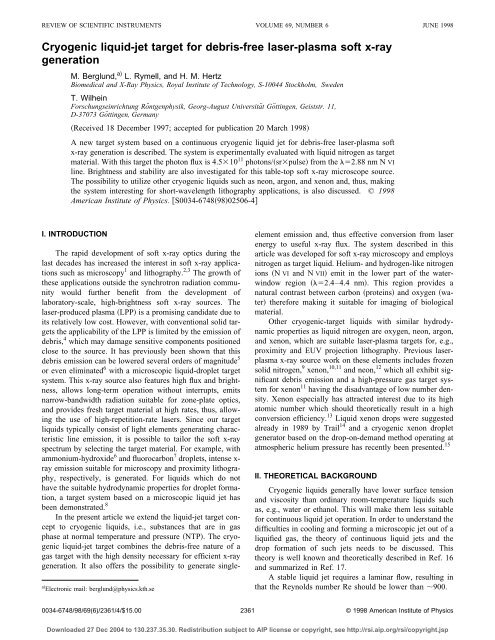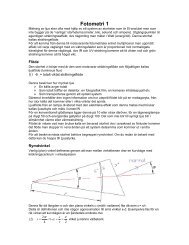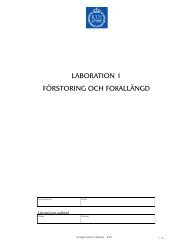Cryogenic liquid-jet target for debris-free laser-plasma soft x-ray ...
Cryogenic liquid-jet target for debris-free laser-plasma soft x-ray ...
Cryogenic liquid-jet target for debris-free laser-plasma soft x-ray ...
Create successful ePaper yourself
Turn your PDF publications into a flip-book with our unique Google optimized e-Paper software.
REVIEW OF SCIENTIFIC INSTRUMENTS VOLUME 69, NUMBER 6 JUNE 1998<br />
<strong>Cryogenic</strong> <strong>liquid</strong>-<strong>jet</strong> <strong>target</strong> <strong>for</strong> <strong>debris</strong>-<strong>free</strong> <strong>laser</strong>-<strong>plasma</strong> <strong>soft</strong> x-<strong>ray</strong><br />
generation<br />
M. Berglund, a) L. Rymell, and H. M. Hertz<br />
Biomedical and X-Ray Physics, Royal Institute of Technology, S-10044 Stockholm, Sweden<br />
T. Wilhein<br />
Forschungseinrichtung Röntgenphysik, Georg-August Universität Göttingen, Geiststr. 11,<br />
D-37073 Göttingen, Germany<br />
�Received 18 December 1997; accepted <strong>for</strong> publication 20 March 1998�<br />
A new <strong>target</strong> system based on a continuous cryogenic <strong>liquid</strong> <strong>jet</strong> <strong>for</strong> <strong>debris</strong>-<strong>free</strong> <strong>laser</strong>-<strong>plasma</strong> <strong>soft</strong><br />
x-<strong>ray</strong> generation is described. The system is experimentally evaluated with <strong>liquid</strong> nitrogen as <strong>target</strong><br />
material. With this <strong>target</strong> the photon flux is 4.5�1011 photons/�sr�pulse� from the ��2.88 nm N VI<br />
line. Brightness and stability are also investigated <strong>for</strong> this table-top <strong>soft</strong> x-<strong>ray</strong> microscope source.<br />
The possibility to utilize other cryogenic <strong>liquid</strong>s such as neon, argon, and xenon and, thus, making<br />
the system interesting <strong>for</strong> short-wavelength lithography applications, is also discussed. © 1998<br />
American Institute of Physics. �S0034-6748�98�02506-4�<br />
I. INTRODUCTION<br />
The rapid development of <strong>soft</strong> x-<strong>ray</strong> optics during the<br />
last decades has increased the interest in <strong>soft</strong> x-<strong>ray</strong> applications<br />
such as microscopy 1 and lithography. 2,3 The growth of<br />
these applications outside the synchrotron radiation community<br />
would further benefit from the development of<br />
laboratory-scale, high-brightness <strong>soft</strong> x-<strong>ray</strong> sources. The<br />
<strong>laser</strong>-produced <strong>plasma</strong> �LPP� is a promising candidate due to<br />
its relatively low cost. However, with conventional solid <strong>target</strong>s<br />
the applicability of the LPP is limited by the emission of<br />
<strong>debris</strong>, 4 which may damage sensitive components positioned<br />
close to the source. It has previously been shown that this<br />
<strong>debris</strong> emission can be lowered several orders of magnitude 5<br />
or even eliminated 6 with a microscopic <strong>liquid</strong>-droplet <strong>target</strong><br />
system. This x-<strong>ray</strong> source also features high flux and brightness,<br />
allows long-term operation without interrupts, emits<br />
narrow-bandwidth radiation suitable <strong>for</strong> zone-plate optics,<br />
and provides fresh <strong>target</strong> material at high rates, thus, allowing<br />
the use of high-repetition-rate <strong>laser</strong>s. Since our <strong>target</strong><br />
<strong>liquid</strong>s typically consist of light elements generating characteristic<br />
line emission, it is possible to tailor the <strong>soft</strong> x-<strong>ray</strong><br />
spectrum by selecting the <strong>target</strong> material. For example, with<br />
ammonium-hydroxide 6 and fluorocarbon 7 droplets, intense x<strong>ray</strong><br />
emission suitable <strong>for</strong> microscopy and proximity lithography,<br />
respectively, is generated. For <strong>liquid</strong>s which do not<br />
have the suitable hydrodynamic properties <strong>for</strong> droplet <strong>for</strong>mation,<br />
a <strong>target</strong> system based on a microscopic <strong>liquid</strong> <strong>jet</strong> has<br />
been demonstrated. 8<br />
In the present article we extend the <strong>liquid</strong>-<strong>jet</strong> <strong>target</strong> concept<br />
to cryogenic <strong>liquid</strong>s, i.e., substances that are in gas<br />
phase at normal temperature and pressure �NTP�. The cryogenic<br />
<strong>liquid</strong>-<strong>jet</strong> <strong>target</strong> combines the <strong>debris</strong>-<strong>free</strong> nature of a<br />
gas <strong>target</strong> with the high density necessary <strong>for</strong> efficient x-<strong>ray</strong><br />
generation. It also offers the possibility to generate single-<br />
a� Electronic mail: berglund@physics.kth.se<br />
element emission and, thus effective conversion from <strong>laser</strong><br />
energy to useful x-<strong>ray</strong> flux. The system described in this<br />
article was developed <strong>for</strong> <strong>soft</strong> x-<strong>ray</strong> microscopy and employs<br />
nitrogen as <strong>target</strong> <strong>liquid</strong>. Helium- and hydrogen-like nitrogen<br />
ions �N VI and N VII� emit in the lower part of the waterwindow<br />
region ���2.4–4.4 nm�. This region provides a<br />
natural contrast between carbon �proteins� and oxygen �water�<br />
there<strong>for</strong>e making it suitable <strong>for</strong> imaging of biological<br />
material.<br />
Other cryogenic-<strong>target</strong> <strong>liquid</strong>s with similar hydrodynamic<br />
properties as <strong>liquid</strong> nitrogen are oxygen, neon, argon,<br />
and xenon, which are suitable <strong>laser</strong>-<strong>plasma</strong> <strong>target</strong>s <strong>for</strong>, e.g.,<br />
proximity and EUV projection lithography. Previous <strong>laser</strong><strong>plasma</strong><br />
x-<strong>ray</strong> source work on these elements includes frozen<br />
solid nitrogen, 9 xenon, 10,11 and neon, 12 which all exhibit significant<br />
<strong>debris</strong> emission and a high-pressure gas <strong>target</strong> system<br />
<strong>for</strong> xenon 11 having the disadvantage of low number density.<br />
Xenon especially has attracted interest due to its high<br />
atomic number which should theoretically result in a high<br />
conversion efficiency. 13 Liquid xenon drops were suggested<br />
already in 1989 by Trail 14 and a cryogenic xenon droplet<br />
generator based on the drop-on-demand method operating at<br />
atmospheric helium pressure has recently been presented. 15<br />
II. THEORETICAL BACKGROUND<br />
<strong>Cryogenic</strong> <strong>liquid</strong>s generally have lower surface tension<br />
and viscosity than ordinary room-temperature <strong>liquid</strong>s such<br />
as, e.g., water or ethanol. This will make them less suitable<br />
<strong>for</strong> continuous <strong>liquid</strong> <strong>jet</strong> operation. In order to understand the<br />
difficulties in cooling and <strong>for</strong>ming a microscopic <strong>jet</strong> out of a<br />
liquified gas, the theory of continuous <strong>liquid</strong> <strong>jet</strong>s and the<br />
drop <strong>for</strong>mation of such <strong>jet</strong>s needs to be discussed. This<br />
theory is well known and theoretically described in Ref. 16<br />
and summarized in Ref. 17.<br />
A stable <strong>liquid</strong> <strong>jet</strong> requires a laminar flow, resulting in<br />
that the Reynolds number Re should be lower than �900.<br />
0034-6748/98/69(6)/2361/4/$15.00 2361<br />
© 1998 American Institute of Physics<br />
Downloaded 27 Dec 2004 to 130.237.35.30. Redistribution subject to AIP license or copyright, see http://rsi.aip.org/rsi/copyright.jsp
2362 Rev. Sci. Instrum., Vol. 69, No. 6, June 1998 Berglund et al.<br />
FIG. 1. Schematic nozzle design <strong>for</strong> stable <strong>liquid</strong>-nitrogen <strong>liquid</strong>-<strong>jet</strong> operation.<br />
Here<br />
Re� ��d<br />
, �1�<br />
�<br />
where d is the diameter, � the velocity, � the density, and �<br />
the viscosity of the <strong>liquid</strong> <strong>jet</strong>. Clearly, a low-viscosity <strong>liquid</strong><br />
such as <strong>liquid</strong> nitrogen is difficult to operate, especially in<br />
combination with large-diameter nozzles. The low viscosity<br />
will limit the <strong>jet</strong> diameter in order to keep the Reynolds<br />
number below �900.<br />
A cylindrical <strong>liquid</strong> <strong>jet</strong> is inherently unstable and tends<br />
to spontaneously break up into drops. This drop <strong>for</strong>mation is<br />
due to minimization of surface energy and occurs at a<br />
break-up distance L �the spontaneous drop <strong>for</strong>mation distance�<br />
from the nozzle orifice. Here<br />
L�12��� �d3<br />
3�d<br />
�<br />
� � � , �2�<br />
where � is the surface tension. In order to generate a stable<br />
train of equally sized and equally spaced drops, the nozzle<br />
must be stimulated at a certain frequency close to the spontaneous<br />
drop <strong>for</strong>mation frequency. With a well-designed<br />
nozzle this can be achieved by, e.g., vibrating it with a piezocrystal.<br />
Due to growing <strong>jet</strong> instabilities far away from the<br />
nozzle orifice, a reasonably short drop <strong>for</strong>mation distance is<br />
necessary. This will make <strong>liquid</strong> nitrogen and similar <strong>liquid</strong>s,<br />
having low surface tension and, thus, long break-up lengths<br />
inappropriate <strong>for</strong> stable droplet production. There<strong>for</strong>e the<br />
<strong>liquid</strong>-<strong>jet</strong> method 8 was chosen in the present article.<br />
III. EXPERIMENTS AND DISCUSSION<br />
The experiments described in this article were per<strong>for</strong>med<br />
with <strong>liquid</strong> nitrogen as <strong>target</strong> material. We have investigated<br />
x-<strong>ray</strong> flux, brightness, <strong>debris</strong> emission, and stability of this<br />
new <strong>laser</strong>-<strong>plasma</strong> x-<strong>ray</strong> source.<br />
The <strong>liquid</strong>-nitrogen <strong>jet</strong> is generated in a vacuum chamber.<br />
Figure 1 shows the schematic nozzle design. The <strong>liquid</strong><br />
<strong>jet</strong> is <strong>for</strong>med by <strong>for</strong>cing the cryogenic <strong>liquid</strong> with a pressure<br />
of �35 bar through an �5 �m diameter orifice. We use a<br />
commercially available electron microscope aperture as the<br />
orifice. A metal filter is mounted inside the nozzle to obstruct<br />
FIG. 2. Microscope image of a stable 5 �m diameter <strong>liquid</strong>-nitrogen <strong>jet</strong> in<br />
vacuum.<br />
dust particles, which could clog the orifice. In Fig. 2, a microscopic<br />
image of the stable <strong>liquid</strong>-nitrogen <strong>jet</strong> is presented.<br />
With our current arrangement the nozzle exit diameter is<br />
limited by vacuum considerations and probably also by Reynolds<br />
number. With a 500 l /s turbomolecular pump the<br />
pressure in the chamber is 1�10 �3 mbar. At this pressure<br />
the absorption in the water-window wavelength region is less<br />
than 1% per meter <strong>for</strong> nitrogen, thus, making it negligible. If<br />
it is necessary to work with better vacuum conditions, this<br />
may be arranged with a larger vacuum pump or with a differential<br />
pumping stage. The cryogenic <strong>target</strong> <strong>liquid</strong> requires<br />
a cooling system <strong>for</strong> the nozzle and construction materials<br />
that can endure low temperatures in combination with high<br />
pressures. In our current arrangement the cooling of the <strong>target</strong><br />
<strong>liquid</strong> is maintained by a <strong>liquid</strong>-nitrogen system and the<br />
nozzle is made of metal, mainly stainless steel. The rigid<br />
construction complicates the stimulation necessary <strong>for</strong> stable<br />
drop generation and consequently the <strong>liquid</strong>-<strong>jet</strong> approach is<br />
applied. 8 XYZ translation of the nozzle from outside the<br />
vacuum chamber is available, making it easy to adjust the<br />
<strong>liquid</strong> <strong>jet</strong> to the <strong>laser</strong> focus inside the vacuum chamber.<br />
The x-<strong>ray</strong>-generating <strong>laser</strong> <strong>plasma</strong> is produced by focusing<br />
��532 nm, 70 mJ, 100 ps pulses from a 10 Hz modelocked<br />
Nd:YAG <strong>laser</strong> �with a 3 mJ, ��355 nm prepulse <strong>for</strong><br />
x-<strong>ray</strong> flux enhancement 18 � onto the <strong>liquid</strong> <strong>jet</strong>. With a diameter<br />
of �12 �m �FWHM� this pulse results in a peak intensity<br />
of 4�10 14 W/cm 2 , which is suitable <strong>for</strong> water-window<br />
<strong>soft</strong> x-<strong>ray</strong> generation. The emitted x-<strong>ray</strong> photon flux was<br />
monitored at 45° angle to the incident <strong>laser</strong> beam with an<br />
x-<strong>ray</strong> diode �Hamamatsu G-1127-02� covered by a 1050 nm<br />
<strong>free</strong>-standing Ti filter. With this filter the diode signal is due<br />
to the N VI line at ��2.88 nm �cf. Fig. 4�.<br />
The spectrum was recorded with a 10 000 lines/mm <strong>free</strong>standing<br />
transmission grating 19 covered by a 250 nm thick<br />
Al filter to remove visible light. An x-<strong>ray</strong> sensitive CCD<br />
�Photometrics AT200L with Tektronix TK1024AB� was<br />
used as detector. Figure 3 shows the spectrum which has<br />
been corrected <strong>for</strong> the wavelength dependence of the grating,<br />
filter and CCD. The absolute efficiency of both the grating<br />
and the CCD were calibrated using synchrotron radiation<br />
from the Berlin electron storage ring �BESSY� thus allowing<br />
us to measure absolute photon numbers. With the geometry<br />
used, an exposure time of 60 s �utilizing the full CCD capacity�<br />
and a resolution of �/���100 were achieved. In imaging<br />
applications, where zone plates are used, it is important<br />
Downloaded 27 Dec 2004 to 130.237.35.30. Redistribution subject to AIP license or copyright, see http://rsi.aip.org/rsi/copyright.jsp
Rev. Sci. Instrum., Vol. 69, No. 6, June 1998 Berglund et al.<br />
FIG. 3. Fully corrected spectrum from cryogenic <strong>liquid</strong>-<strong>jet</strong> nitrogen <strong>target</strong>.<br />
to have a monochromatic light source in order to avoid chromatic<br />
aberrations. With our source this can be accomplished<br />
by using a titanium filter. Figure 4 shows the spectrum filtered<br />
by 700 nm Ti.<br />
By integrating over the linewidth the photon flux <strong>for</strong> a<br />
line can be measured. This was done <strong>for</strong> the ��2.88 nm N VI<br />
line resulting in 4.5�10 11 photons/�sr�pulse� unfiltered.<br />
This number is 1.4� higher than what was achieved with<br />
ammonium hydroxide as <strong>target</strong> <strong>liquid</strong> 20 �32% NH 3 in water<br />
by volume� despite the fact that the <strong>jet</strong> diameter in the<br />
present work �5 �m� is only half of what was used in Ref.<br />
20. We will attempt to increase the photon flux by carefully<br />
designing the nozzle to allow laminar <strong>liquid</strong> nitrogen flow at<br />
larger diameters and consequently creating more <strong>target</strong> material<br />
in focus.<br />
In many imaging applications, including microscopy,<br />
brightness of the x-<strong>ray</strong> source (photons/sr��m 2 �pulse� is<br />
more important than the total emitted photon flux. For this<br />
reason the size of the <strong>plasma</strong> was measured with an 8 �m<br />
diameter pinhole camera, covered with a 700 nm Ti filter and<br />
with the same type of CCD detector as mentioned above.<br />
With full prepulse operation the source diameter �FWHM� at<br />
��2.88 nm was measured to 35 �m as shown in Fig. 5. This<br />
corresponds well to previously used room-temperature <strong>target</strong><br />
<strong>liquid</strong>s such as ethanol and ammonium hydroxide. In contrast<br />
to these <strong>liquid</strong>s, however, the pinhole camera images<br />
from <strong>liquid</strong> nitrogen exhibit long radial tails of low-intensity<br />
x-<strong>ray</strong> emission �cf. Fig. 5�. One probable reason <strong>for</strong> this is<br />
that the rapid evaporation of the <strong>liquid</strong> nitrogen results in a<br />
thin layer of N 2 gas surrounding the <strong>jet</strong> which contributes to<br />
the x-<strong>ray</strong> generation.<br />
As mentioned in the introduction the <strong>liquid</strong>-<strong>jet</strong> <strong>target</strong> is a<br />
FIG. 4. Titanium-filtered single-line spectrum from cryogenic <strong>liquid</strong>-<strong>jet</strong> nitrogen<br />
<strong>target</strong>.<br />
FIG. 5. Pinhole camera image at ��2.88 nm. Line scans indicate vertical<br />
and horizontal cross sections.<br />
low-<strong>debris</strong> source. It is common to distinguish between<br />
atomic/ionic and particulate �here, frozen nitrogen or small<br />
<strong>liquid</strong> droplets� <strong>debris</strong>. The atomic/ionic <strong>debris</strong> results in a<br />
coating on, e.g., x-<strong>ray</strong> optical components positioned close to<br />
the source, thereby slowly degenerating the components.<br />
Particulate <strong>debris</strong>, due to its larger mass, may often directly<br />
damage optics and filters. We have previously shown that a<br />
size-optimized <strong>liquid</strong> <strong>target</strong> consisting of only gaseous components<br />
results in <strong>debris</strong>-<strong>free</strong> <strong>laser</strong>-<strong>plasma</strong> operation. 6 To<br />
verify the absence of particulate <strong>debris</strong> from the <strong>liquid</strong>nitrogen<br />
source, thin metal filters �300 nm Ti� with a diameter<br />
of 5 mm were positioned �60 mm from the source.<br />
After several hours of 10 Hz <strong>plasma</strong> operation the filters<br />
showed no signs of pinholes or other damage.<br />
Another important feature <strong>for</strong> an LPP is spatial stability.<br />
There<strong>for</strong>e the <strong>jet</strong> stability was measured with an optical microscope<br />
3 mm from the nozzle orifice �normal working distance<br />
<strong>for</strong> <strong>plasma</strong> production�. At this distance the <strong>jet</strong> was<br />
found to be stable within the resolution of the microscope<br />
��6 �m�. This is well within the size of the <strong>laser</strong> focus.<br />
Furthermore, the pulse-to-pulse fluctuations of the x-<strong>ray</strong><br />
emission was estimated to �25%. This is the same value as<br />
we have previously achieved with ethanol as <strong>target</strong> <strong>liquid</strong> 18<br />
and indicates that the <strong>liquid</strong>-nitrogen <strong>jet</strong> is spatially stable.<br />
The main reason <strong>for</strong> the fluctuations is pulse-to-pulse variations<br />
of the prepulse intensity. An unresolved problem is that<br />
the <strong>jet</strong> occasionally changes direction with several degrees.<br />
This only occurs when the <strong>laser</strong> is focused on the <strong>jet</strong> and the<br />
phenomenon is not fully understood yet. We have observed<br />
the same behavior when operating the metal nozzle with ethanol<br />
as <strong>target</strong> <strong>liquid</strong>. One possible explanation is a charging<br />
effect in combination with the metal nozzle.<br />
IV. DISCUSSION<br />
2363<br />
We have developed a <strong>soft</strong> x-<strong>ray</strong> source based on a cryogenic<br />
<strong>liquid</strong>-<strong>jet</strong> <strong>target</strong>. With nitrogen as <strong>target</strong> <strong>liquid</strong> this<br />
source is a promising x-<strong>ray</strong> source candidate <strong>for</strong> future tabletop<br />
x-<strong>ray</strong> microscopes. This source works <strong>for</strong> a full day of 10<br />
Hz operation in a 10 �3 mbar vacuum chamber, i.e., no buffer<br />
Downloaded 27 Dec 2004 to 130.237.35.30. Redistribution subject to AIP license or copyright, see http://rsi.aip.org/rsi/copyright.jsp
2364 Rev. Sci. Instrum., Vol. 69, No. 6, June 1998 Berglund et al.<br />
gas is necessary. A theoretical investigation of the hydrodynamic<br />
properties of <strong>liquid</strong> oxygen, xenon, and neon shows<br />
that these <strong>liquid</strong>s may also be used as <strong>target</strong> material. Thus,<br />
the arrangement presented in this article is an interesting<br />
source also <strong>for</strong> proximity ���1 nm�and EUV ���13 nm�<br />
lithography. Compared to existing xenon <strong>target</strong> systems 11,15<br />
our approach will allow <strong>for</strong> a potentially <strong>debris</strong>-<strong>free</strong> source<br />
with high brightness, long operating times with highrepetition-rate<br />
<strong>laser</strong>s and full vacuum compatibility.<br />
ACKNOWLEDGMENTS<br />
The authors gratefully acknowledge D. Hambach and S.<br />
Rehbein <strong>for</strong> manufacturing the grating and G. Schmahl <strong>for</strong><br />
his support. This work was financed by the Swedish Research<br />
Council <strong>for</strong> Engineering Sciences, the Swedish Natural<br />
Science Research Council, the Wallenberg Foundation,<br />
and the EC Human Capital and Mobility program.<br />
1 X-Ray Microscopy and Spectromicroscopy, edited by J. Thieme, G.<br />
Schmahl, D. Rudolph, and E. Umbach �Springer, Heidelberg, in press�.<br />
2 H. I. Smith and M. L. Schattenburg, IBM J. Res. Dev. 37, 319 �1993�.<br />
3 See, e.g., several papers in OSA Trends in Optics and Photonics Vol. 4,<br />
Extreme Ultraviolet Lithography, edited by G. D. Kubiak and D. R. Kania<br />
�Optical Society of America, Washington, DC, 1996�.<br />
4 M. Richardson W. T. Silfvast, H. A. Bender, A. Hanzo, V. P. Yanovsky,<br />
F. Jin, and J. Thorpe, Appl. Opt. 32, 6901 �1993�.<br />
5 L. Rymell and H. M. Hertz, Opt. Commun. 103, 105 �1993�.<br />
6 L. Rymell, M. Berglund, and H. M. Hertz, Appl. Phys. Lett. 66, 2625<br />
�1995�.<br />
7 L. Malmqvist, L. Rymell, and H. M. Hertz, Appl. Phys. Lett. 68, 2627<br />
�1996�.<br />
8 L. Malmqvist, L. Rymell, M. Berglund, and H. M. Hertz, Rev. Sci. In-<br />
strum. 67, 4150 �1996�.<br />
9 R. Lebert, Aachen Germany �personal communication�.<br />
10 G. D. Kubiak, K. D. Krenz, K. W. Berger, T. G. Trucano, P. W. Fisher,<br />
and M. J. Gouge, in OSA Proceedings on Extreme Ultraviolet Lithography<br />
Vol. 23, edited by D. Attwood and F. Zernike �Optical Society of<br />
America, Washington, DC, 1995�, p. 248.<br />
11 P. Celliers et al., J. Appl. Phys. 79, 8258 �1996�.<br />
12 R. H. Dixon, J. L. Ford, T. N. Lee, and R. C. Elton, Rev. Sci. Instrum. 56,<br />
471 �1985�.<br />
13 P. K. Carrol and E. T. Kennedy, Contemp. Phys. 22, 61�1981�.<br />
14 J. A. Trail, Ph.D. thesis, Stan<strong>for</strong>d University, Stan<strong>for</strong>d, CA, 1989.<br />
15 M. J. Gouge and P. W. Fisher, Rev. Sci. Instrum. 68, 2158 �1997�.<br />
16 M. J. McCarthy and N. A. Molloy, Chem. Eng. J. 7, 1�1974�.<br />
17 H. M. Hertz, L. Rymell, M. Berglund, and L. Malmqvist, Proc. SPIE<br />
2523, 88�1995�.<br />
18 M. Berglund, L. Rymell, and H. M. Hertz, Appl. Phys. Lett. 69, 1683<br />
�1996�.<br />
19 T. Wilhein, D. Hambach, S. Rehbein, M. Berglund, L. Rymell, and H. M.<br />
Hertz �unpublished�.<br />
20 T. Wilhein, D. Hambach, B. Niemann, M. Berglund, L. Rymell, and H. M.<br />
Hertz, Appl. Phys. Lett. 71, 190 �1997�.<br />
Downloaded 27 Dec 2004 to 130.237.35.30. Redistribution subject to AIP license or copyright, see http://rsi.aip.org/rsi/copyright.jsp








